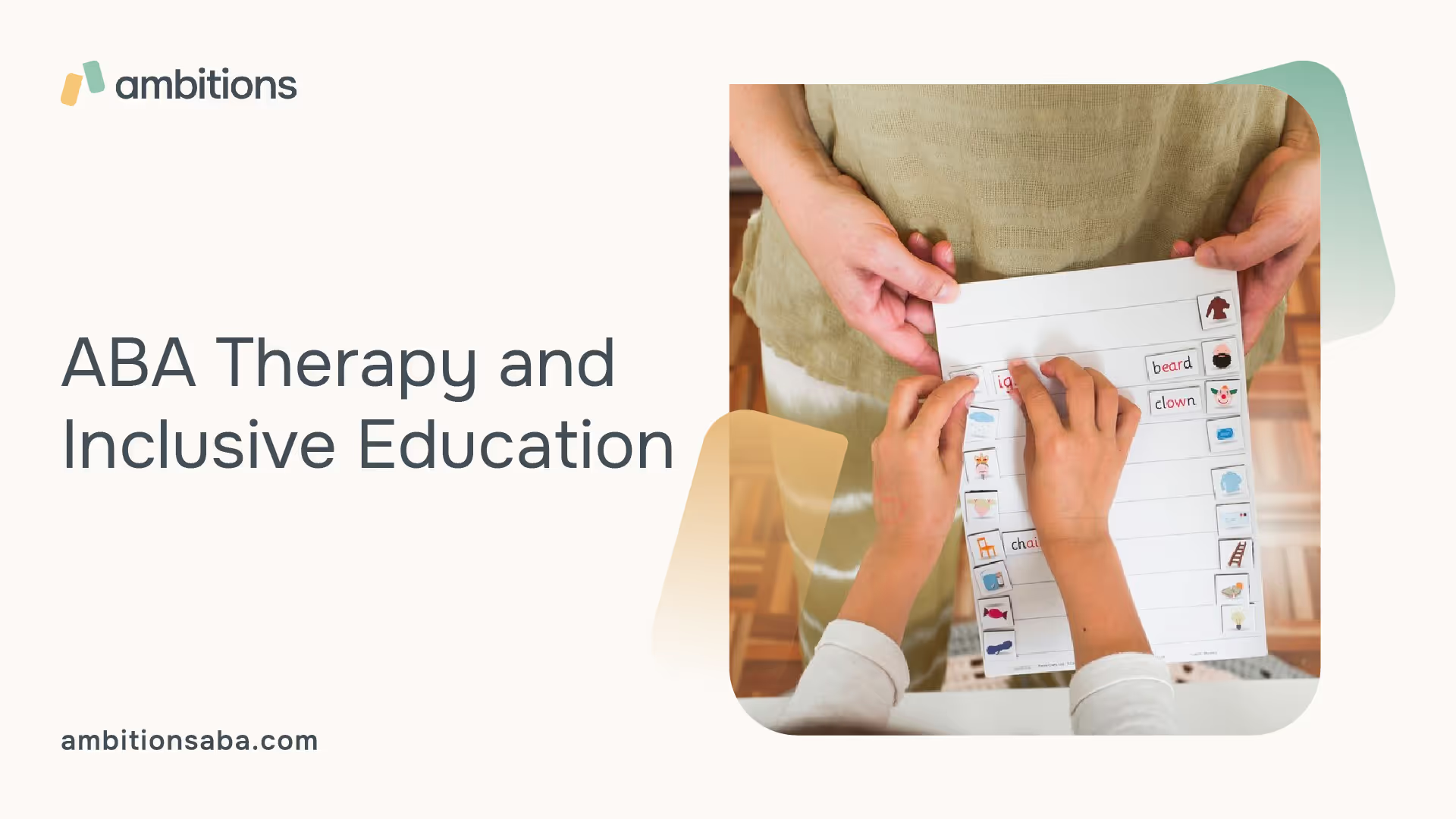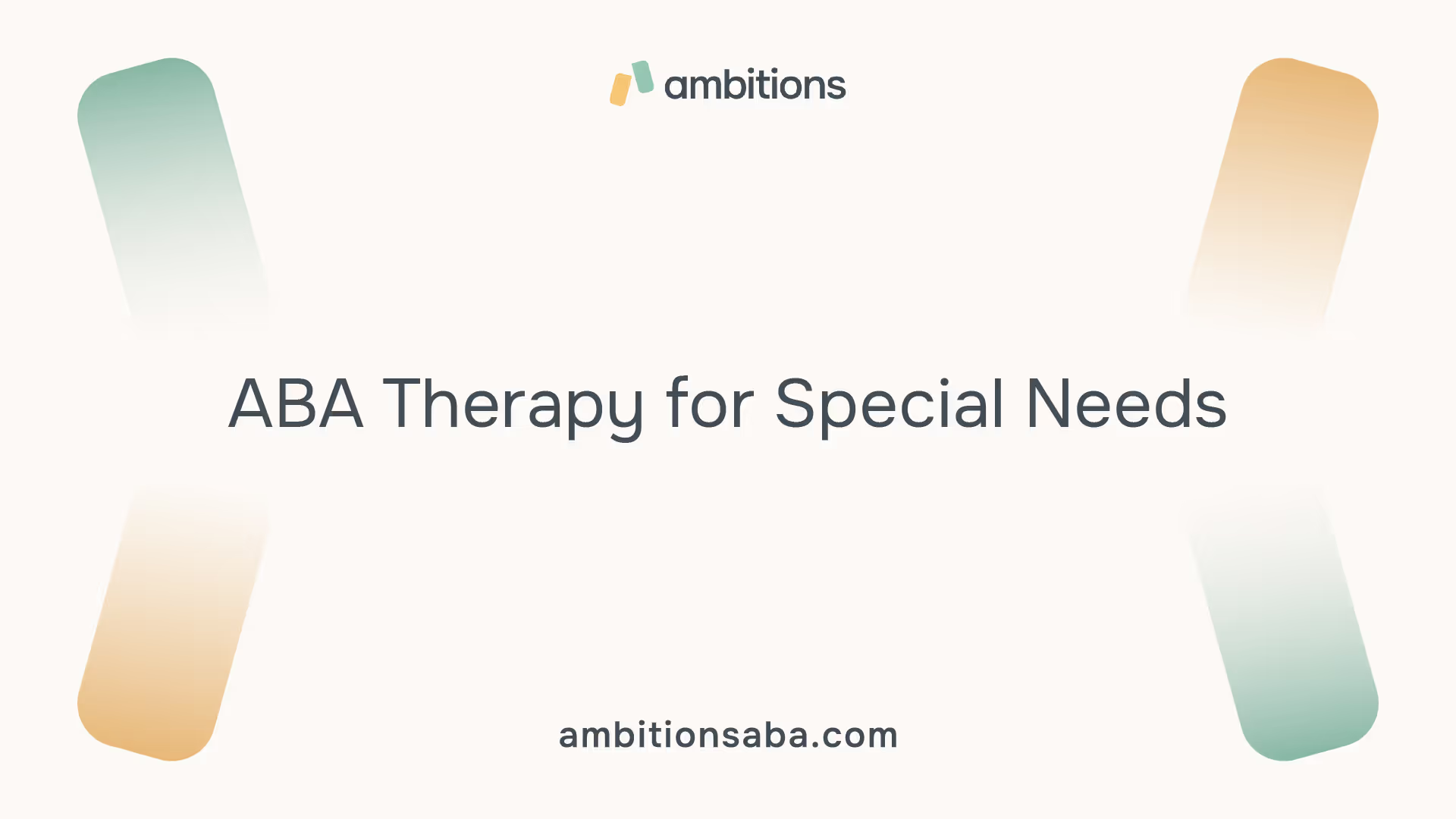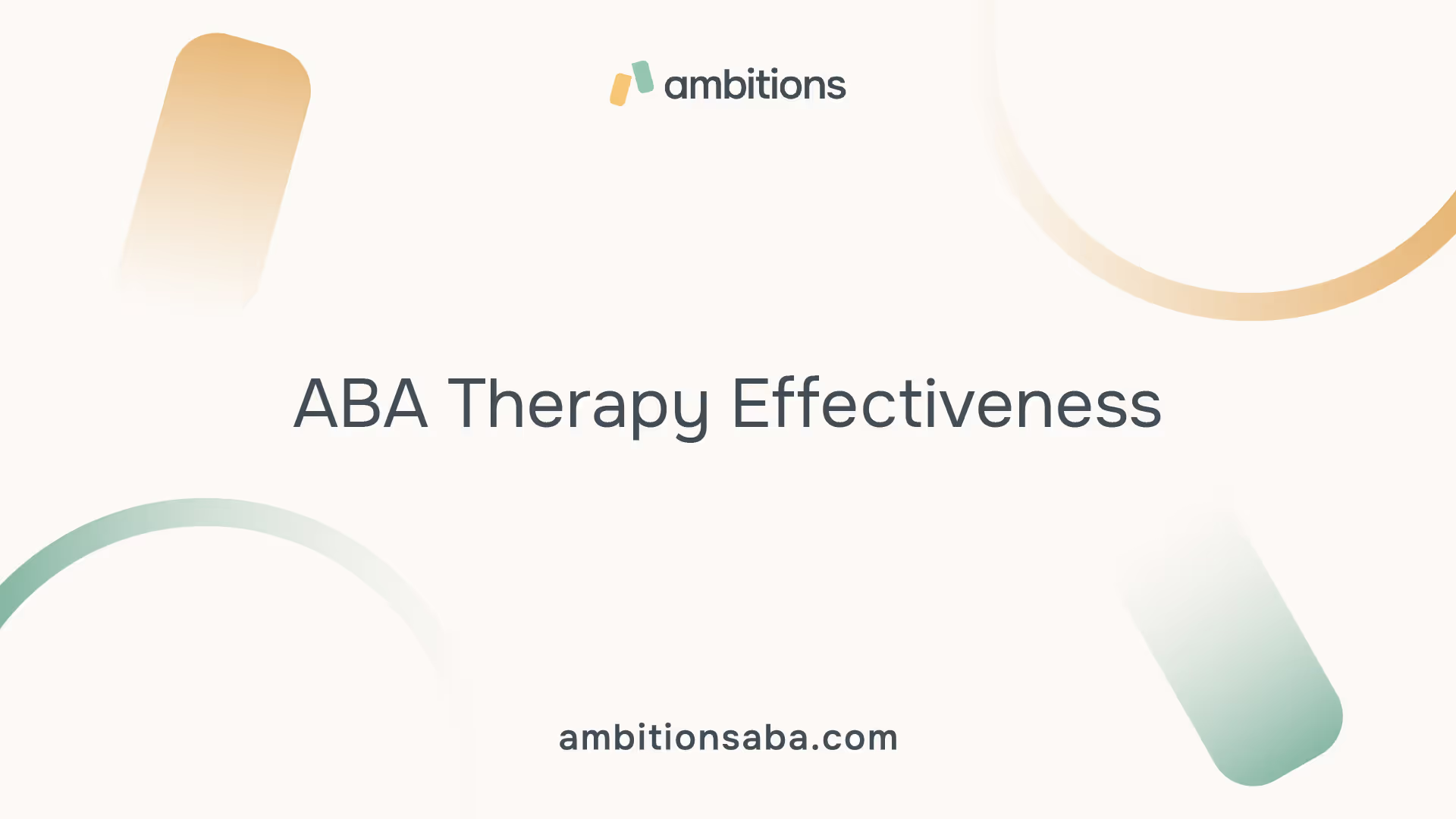Discover effective strategies for promoting positive behavior in autism and supporting your child's development!

Understanding ABA Therapy
ABA therapy, or applied behavior analysis therapy, is an evidence-based approach that has shown significant benefits for children with autism spectrum disorder (ASD) and other special needs. This therapy focuses on understanding behavior and using that understanding to bring about positive changes in a person's life.
Benefits of ABA Therapy
ABA therapy has been found to be highly effective in improving social, communication, and academic skills in children with ASD. In fact, over 90% of children treated with ABA therapy have shown significant improvement in these areas [1]. The gains achieved through ABA therapy often continue even after the treatment ends, making it the "gold standard" of autism treatments.
By using specific techniques and strategies, ABA therapy helps individuals with special needs learn new skills and behaviors while also reducing challenging behaviors. This can lead to increased independence and better quality of life for the individual. ABA therapy is based on the principle of learning through observation and imitation, allowing children with ASD to develop crucial communication, social, and academic skills.
Principles of ABA Therapy
ABA therapy is guided by several key principles that contribute to its effectiveness. These principles include:
- Individualization: ABA therapy takes an individualized approach, tailoring interventions to the specific needs of each child. This ensures that the therapy addresses their unique challenges and goals. By understanding the needs of the individual, ABA therapists can create personalized programs that focus on skill development and behavior improvement.
- Targeted Skill Development: ABA therapy focuses on teaching targeted skills that are important for the individual's daily life and future independence. These skills can include communication, social interaction, self-care, academic skills, and more. ABA therapists use various techniques, such as prompting, shaping, and reinforcement, to help individuals acquire and generalize these skills.
By following these principles, ABA therapy provides a structured and systematic approach to support children with special needs. It helps them understand their needs, develop positive behaviors, and achieve personal goals tailored to their unique circumstances. ABA therapy is not limited to children with ASD but can benefit any child struggling to meet developmental milestones or displaying challenging behaviors.

ABA Therapy for Special Needs
In the realm of inclusive education, ABA therapy plays a vital role in supporting individuals with special needs, including those diagnosed with Autism Spectrum Disorder (ASD). ABA therapy can be beneficial not only for children with ASD but also for those struggling to meet developmental milestones or displaying challenging behaviors.
Individualized Approach
One of the key aspects of ABA therapy is its individualized approach. Each child receives personalized treatment and intervention plans based on their unique needs and goals. A qualified ABA therapist conducts assessments to identify specific areas of improvement, such as communication, socialization, and academic skills. By understanding the child's strengths and challenges, the therapist can design interventions tailored to their specific requirements.
The individualized approach allows ABA therapy to address the specific needs of each child, working towards their personal goals. Whether it's improving communication skills, reducing challenging behaviors, or acquiring new skills, the therapy is customized to meet the child's unique needs and help them reach their full potential.
Targeted Skill Development
ABA therapy focuses on targeted skill development, aiming to enhance various aspects of a child's life. The therapy utilizes evidence-based techniques to teach and reinforce desired behaviors while reducing behaviors that interfere with learning and social interactions. By employing strategies such as Discrete Trial Teaching (DTT), Naturalistic Teaching, Pivotal Response Treatment (PRT), Token Economy, and Peer-mediated Interventions, ABA therapists guide students through skill acquisition across different populations and settings [2].
ABA therapy in schools is particularly effective in improving academic skills, reducing behaviors that hinder learning, and providing guidance in social situations. The therapy enables students to develop a wide range of skills, including language capabilities, communication skills, and social interactions. By targeting specific areas for improvement, ABA therapy helps students with special needs succeed academically and socially.
Implementing ABA therapy in schools requires collaboration between ABA therapists, teachers, and other professionals to ensure a consistent approach across different environments. A collaborative and multidisciplinary team approach ensures that students receive comprehensive support and interventions tailored to their specific needs.
By employing an individualized approach and focusing on targeted skill development, ABA therapy helps students with special needs make significant progress in their academic, social, and emotional development. The integration of ABA therapy in inclusive education settings fosters a supportive and inclusive environment where every child has the opportunity to thrive.

ABA Therapy Effectiveness
When considering the effectiveness of ABA therapy in the context of inclusive education, it's important to examine both the long-term outcomes and the importance of early intervention.
Long-Term Outcomes
Over 90% of children treated with applied behavior analysis (ABA) significantly improve their social, communication, and academic skills. ABA therapy often results in long-term gains that continue even after treatment ends, making it the "gold standard" of autism treatments.
A study conducted by Lovaas in the 1970s found that 47% of children who participated in ABA treatment reached normal intellectual and educational functioning compared to only 2% of a control group. This groundbreaking research was part of the UCLA Young Autism Project model, which aimed to alter behaviors to improve social interactions in children diagnosed with autism spectrum disorder (ASD) [3].
These long-term outcomes highlight the transformative impact of ABA therapy on individuals with ASD. The comprehensive, individualized approach of ABA helps children develop essential life skills, enabling them to navigate social situations, communicate effectively, and excel academically.
Early Intervention Importance
Early diagnosis and intervention are crucial for positive outcomes in children with autism spectrum disorder (ASD). Children receiving long-term applied behavior analysis (ABA) therapy experienced a 47% improvement in intellectual function. Early ABA interventions can help minimize and, at times, prevent the long-term difficulties associated with ASD [5].
Research consistently shows that children who receive ABA therapy at a younger age tend to have better outcomes. The brain is more malleable during early childhood, making it an optimal time for intervention and learning. By identifying and addressing developmental delays and challenges early on, ABA therapy can help children develop crucial skills and bridge the gaps in their development.
Early intervention allows for targeted skill development, focusing on areas such as communication, social interaction, and adaptive behaviors. By implementing ABA therapy in the early years, children with ASD can have a greater chance of reaching their full potential and thriving in inclusive educational settings.
By emphasizing long-term outcomes and the significance of early intervention, ABA therapy plays a vital role in supporting the inclusive education of children with ASD. The individualized approach of ABA, combined with the commitment of educators, therapists, and families, creates an environment where children can grow, learn, and succeed in their educational journey.
Implementing ABA in Schools
Implementing Applied Behavior Analysis (ABA) therapy in schools has become widely recognized as an effective approach to support students with diverse needs, including those with Autism Spectrum Disorder (ASD). It offers numerous benefits, such as enhancing learning outcomes and providing crucial support for students with ASD. Here, we will explore the benefits of ABA in schools and strategies for integrating ABA techniques into the classroom environment.
Benefits of ABA in Schools
ABA therapy in schools focuses on improving academic skills, reducing behaviors that interfere with learning, and guiding children through social situations. By utilizing various teaching strategies such as Discrete Trial Teaching (DTT), Naturalistic Teaching, Pivotal Response Treatment (PRT), Token Economy, and Peer-mediated Interventions, ABA therapists help students develop a wide range of skills across different populations and settings.
The benefits of implementing ABA in schools include:
- Enhanced Learning Outcomes: ABA techniques are tailored to individual students' needs, allowing for targeted skill development and improved academic performance.
- Behavior Management: ABA therapists help identify and address behaviors that may hinder learning, creating a more conducive learning environment.
- Social Skills Development: ABA therapy facilitates the development of social skills by teaching appropriate behavior and social interaction strategies.
- Individualized Approach: ABA therapy in schools provides personalized interventions based on the unique needs and abilities of each student.
- Collaborative Efforts: ABA therapists collaborate with educators, parents, and students themselves to ensure consistent support across different environments.
Strategies for Classroom Integration
Integrating ABA techniques into the classroom environment requires careful planning and collaboration among educators, ABA therapists, parents, and sometimes the students themselves. Here are some strategies for effectively implementing ABA therapy in schools:
- Collaborative Team Approach: A collaborative approach involving multidisciplinary teams is essential for effectively supporting autistic students in schools. This team typically includes educators, ABA therapists, parents, and sometimes the students themselves. Collaborative models such as co-teaching, parent-professional partnerships, and peer-mediated interventions can enhance the implementation of ABA therapy in educational settings.
- Comprehensive Training and Professional Development: Successful integration of ABA therapy in schools requires comprehensive training for teachers and staff on ABA principles and techniques. Ongoing professional development, collaboration with ABA professionals, and performance monitoring are crucial aspects of ensuring that ABA strategies are correctly applied and goals are met in an inclusive educational environment [5].
- Individualized Education Plans (IEPs): Developing and implementing Individualized Education Plans (IEPs) can help ensure that the specific needs of students receiving ABA therapy are addressed. IEPs outline the goals, accommodations, and interventions necessary to support the student's educational journey.
- Visual Supports and Structured Environment: Utilizing visual supports, such as schedules, visual cues, and social stories, can help students with ASD better navigate the classroom environment. Creating a structured and predictable environment can enhance their learning experience and reduce anxiety.
By implementing ABA techniques in schools and fostering an inclusive educational environment, educators can provide essential support for students with diverse needs. Through collaboration, comprehensive training, and individualized approaches, ABA therapy can enhance learning outcomes, promote social skills development, and create a more inclusive classroom environment for all students.
Inclusive Education and ABA
Inclusive education has gained recognition as a vital component in promoting the academic and social development of all children, including those diagnosed with Autism Spectrum Disorder (ASD). By fostering inclusive learning environments, educational institutions can accommodate diverse learning needs and provide opportunities for students with ASD to access high-quality education alongside their neurotypical peers.
Supporting Diverse Needs
One of the key benefits of implementing ABA therapy in schools is its ability to support the diverse needs of students. ABA therapy plays a crucial role in addressing various aspects of individuals' lives affected by ASD. It focuses on improving language capabilities, communication skills, and social interactions while also working to limit negative behaviors.
By incorporating ABA techniques and strategies, schools can create customized programs that cater to the specific needs of students with ASD. ABA therapists work closely with educators, parents, and other professionals to develop individualized plans that enhance learning outcomes and provide crucial support for students with ASD [2].
Fostering Inclusive Environments
Inclusive education goes beyond mere inclusion in the classroom; it aims to create a supportive and inclusive environment for all students. By implementing ABA in schools, educators can create conducive learning environments that enhance the overall educational experience for students with ASD.
ABA therapy utilizes various teaching strategies, such as Discrete Trial Teaching (DTT), Naturalistic Teaching, Pivotal Response Treatment (PRT), Token Economy, and Peer-mediated Interventions. These techniques help students develop a wide range of skills across different populations and settings.
By providing targeted support and teaching strategies, ABA therapists help students with ASD overcome challenges and develop important life skills. Through collaboration with educators, ABA therapists can guide students through social situations, reduce behaviors that interfere with learning, and improve academic skills.
Creating inclusive environments through ABA therapy not only benefits students with ASD but also promotes understanding, acceptance, and empathy among all students. It encourages the development of positive social interactions and relationships, contributing to a more inclusive and harmonious school community.
In summary, the integration of ABA therapy in schools supports diverse needs and fosters inclusive environments. By providing individualized support and utilizing effective teaching strategies, ABA therapy enhances the educational experience for students with ASD, promotes inclusive education, and cultivates an environment where all students can thrive.
A Collaborative Approach
In order to effectively support autistic students in an inclusive educational environment, a collaborative approach that involves the participation of various stakeholders is essential. This collaborative approach typically includes educators, ABA therapists, parents, and sometimes even the students themselves. By working together, these multidisciplinary teams can create a supportive and inclusive educational experience for children with autism.
Multidisciplinary Team Involvement
The involvement of a multidisciplinary team is crucial when implementing ABA therapy in schools. This team may consist of educators, ABA therapists, speech and language pathologists, occupational therapists, and other professionals who play a role in supporting the needs of autistic students. By bringing together the expertise and perspectives of these professionals, a comprehensive and individualized approach to education can be developed.
Collaboration within the multidisciplinary team allows for the sharing of knowledge, strategies, and resources. It facilitates a holistic understanding of the student's strengths, challenges, and goals, enabling the team to develop effective interventions and support plans. Models such as co-teaching, parent-professional partnerships, and peer-mediated interventions can enhance the implementation of ABA therapy in educational settings.
Professional Development for Teachers
Successful integration of ABA therapy in schools requires comprehensive training and professional development for teachers and staff. Teachers play a vital role in implementing ABA strategies and supporting the learning and development of autistic students. Ongoing professional development ensures that teachers have the necessary knowledge and skills to effectively implement ABA principles and techniques in the classroom.
Professional development opportunities should focus on providing teachers with a solid understanding of ABA therapy, its principles, and evidence-based practices. Training should cover topics such as behavior management strategies, data collection and analysis, reinforcement techniques, and individualized instruction. By equipping teachers with these tools, they can create a supportive and structured learning environment that meets the unique needs of autistic students.
Collaboration between teachers and ABA professionals is also crucial. Regular communication and consultation with ABA therapists can provide valuable guidance, feedback, and support to ensure that ABA strategies are correctly applied and goals are effectively met. Performance monitoring and ongoing assessment can help identify areas for improvement and ensure continuous growth and learning within the educational team.
By embracing a collaborative approach that involves multidisciplinary team involvement and providing professional development opportunities for teachers, schools can create inclusive environments that support the academic, social, and emotional growth of students with autism. ABA therapy, when integrated effectively within an educational setting, can contribute to the equitable learning opportunities and success of all students.
References
[1]: https://insightstobehavior.com/blog/connection-aba-special-education-guide/
[2]: https://www.yellowbusaba.com/post/aba-in-schools-and-the-classroom
[3]: https://www.ncbi.nlm.nih.gov/pmc/articles/PMC9458805/
[4]: https://www.ncbi.nlm.nih.gov/pmc/articles/PMC10710535/
[5]: https://www.rubyaba.com/autism-resources/
[6]: https://autismcoe.com/blog/school-readiness/aba-in-inclusive-education/

